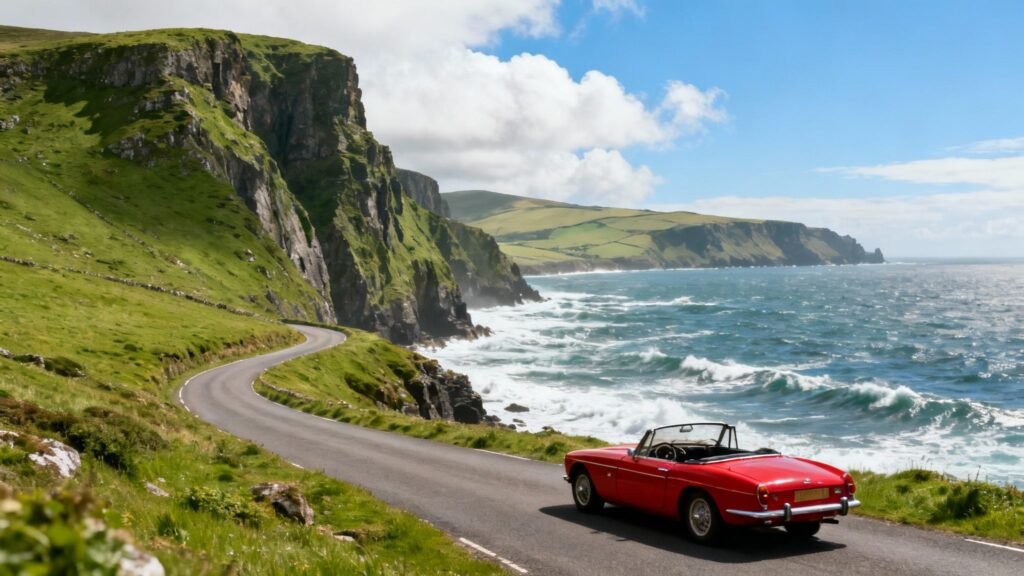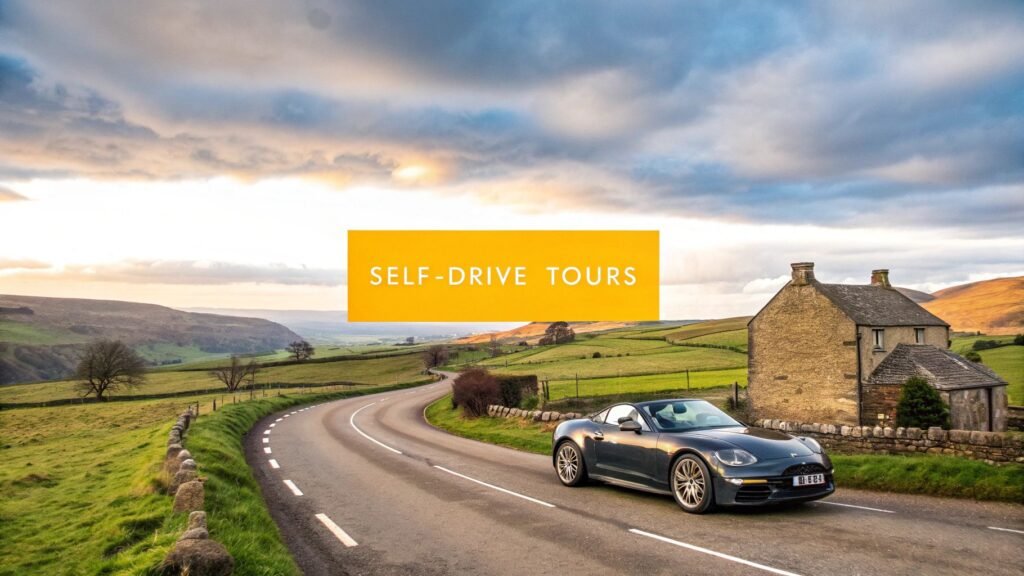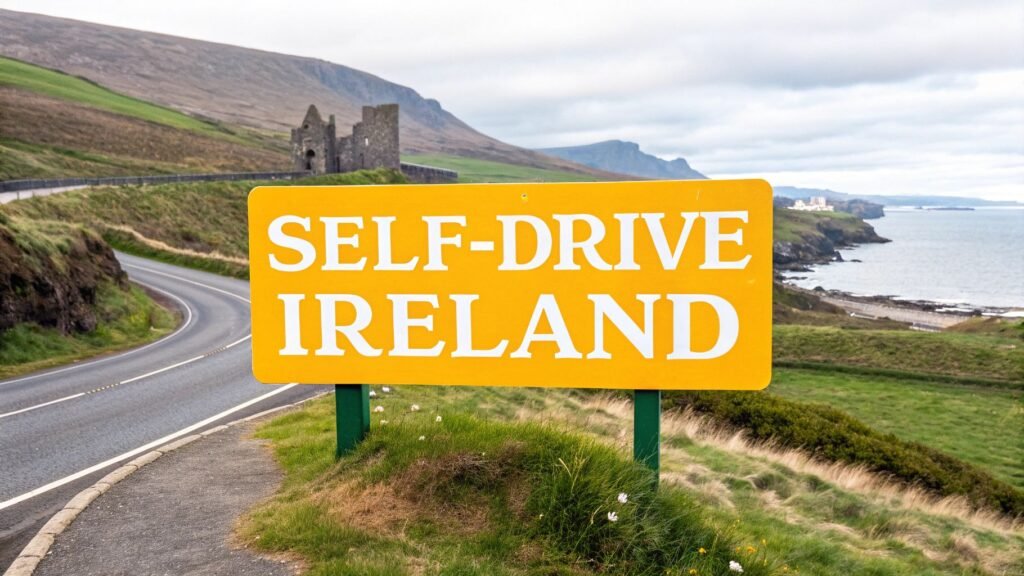A road trip down Ireland's west coast is more than just a holiday; it's a rite of passage for any serious traveller. You'll be taking on the legendary Wild Atlantic Way, a route famous for its heart-stopping cliffs, impossibly charming villages, and roads that twist and turn along the raw edge of the Atlantic. Get ready for an adventure steeped in natural beauty and that famous Irish hospitality.
Your West Coast of Ireland Adventure Awaits
Picture this: your hands are on the wheel, navigating roads that cling to the very edge of Europe. Below you, the wild Atlantic crashes against ancient cliffs. You pull over on a whim to wander through the ruins of a stone fort, and later that evening, you find yourself in a cosy, fire-lit pub, tapping your foot to a live trad session. This isn't just a trip; it's an experience that gets under your skin and stays with you long after you've returned home.
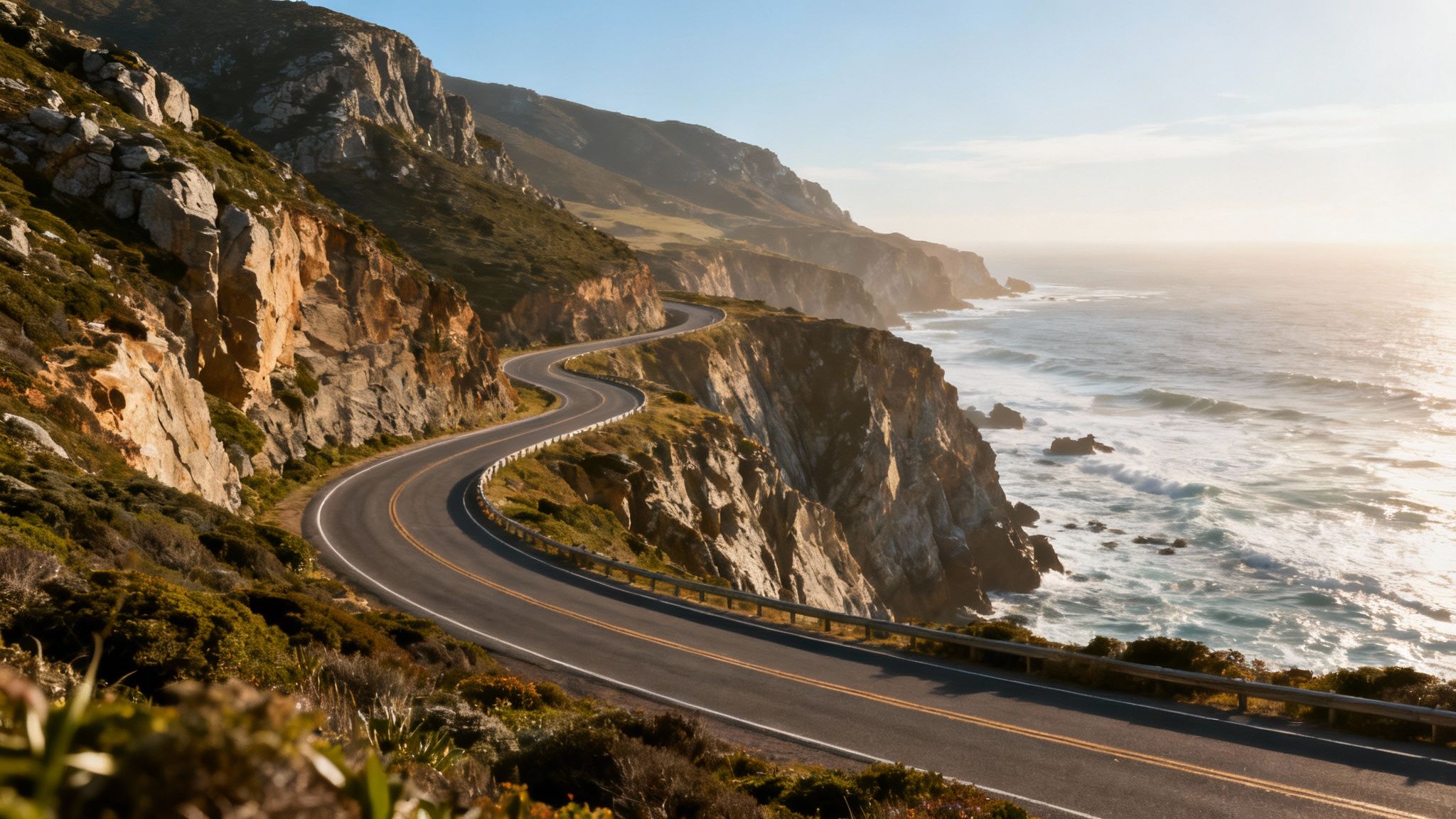
This guide is designed to be your co-pilot for that exact journey. We've poured our experience into mapping out every step of your west coast of Ireland road trip. We'll take you from the rugged, windswept headlands of Donegal all the way down to the gourmet haven of Kinsale, making sure you hit all the must-see spots and uncover a few hidden gems along the way.
What Makes This Route So Special?
The heart and soul of this journey is the Wild Atlantic Way. It's not just a collection of roads, but a brilliantly signposted touring route that perfectly captures the spirit of the Irish coastline. Stretching for more than 2,500 kilometres from County Donegal to County Cork, it's one of the longest defined coastal drives on the planet, yet it feels intimate and completely accessible.
This drive is an absolute feast for the senses, delivering something new around every bend:
- Dramatic Landscapes: You’ll see everything from the sheer, staggering drop of the Cliffs of Moher to the otherworldly, moon-like limestone landscape of the Burren.
- Rich Culture: It's a chance to immerse yourself in authentic Irish traditions, whether you're in the Gaeltacht (Irish-speaking) regions or the lively market towns.
- Complete Freedom: A self-drive tour puts you in control. You have the flexibility to linger wherever you please, be it for that perfect photo or just one more slice of homemade brown bread with a slather of Irish butter.
How This Guide Will Help You Plan
Think of this article as your personal itinerary builder. We’ve broken the entire route down into logical, day-by-day sections, complete with suggestions for what to see, do, and where to stay. We’ll help you figure out how much time to set aside, what you absolutely need to pack, and even give you tips for navigating those famously narrow country lanes like a local. Our mission is to give you all the tools and knowledge you need for a smooth, incredible adventure.
This journey is all about embracing the unexpected. It’s the spontaneous detours down tiny lanes, the friendly chats with locals in a village shop, and the breathtaking views that no photograph can ever truly do justice to. This is your chance to write your own Irish story.
By the time you've finished reading, you'll be more than ready for the drive of a lifetime. And if you'd prefer to have the planning expertly handled, we have a range of self-drive packages that cover the entire emerald isle. Take a look at our touring options in Ireland to get inspired.
How Long Should Your Irish Road Trip Be?
Figuring out how long to spend on the west coast of Ireland is probably the first big question you'll ask yourself. And it's a tricky one. A quick glance at the map can be seriously misleading; those winding coastal roads and the sheer number of places you'll want to stop mean that a seemingly short drive can easily fill an entire day.
To give you a better idea, I’ve laid out three of the most popular trip lengths. Don't think of these as strict itineraries, but more as starting points to build your own perfect adventure. Whether you’ve got a long weekend or a full two weeks, there’s a way to make it unforgettable.
The 5-Day Highlights Tour
Five days is a fantastic, if fast-paced, introduction to the west coast. It’s a brilliant way to get a real flavour of the place, but you absolutely have to be selective. The key here is not to try and see everything. Instead, pick one or two must-see regions and really get to know them.
Your best bet for a five-day trip is to fly into Shannon Airport (SNN). It drops you right into the heart of things, so you can spend your time exploring the absolute icons of County Clare and soaking up the brilliant buzz of Galway.
- What You Can Realistically Cover: Zero in on the magnificent Cliffs of Moher, the otherworldly limestone landscape of the Burren, and the colourful, lively city of Galway. You might even squeeze in a quick drive into the southern edge of Connemara.
- What You’ll Miss: You’ll have to save the rugged, wild peninsulas of Donegal and Mayo up north for another time, along with the beautiful southern coastlines of Cork and Kerry.
Think of this as the perfect taster menu. It’s ideal for first-timers who want to hit the big-name sights and get a feel for the west, leaving you with plenty of reasons to come back for more.
The 10-Day Deep Dive
Honestly, 10 days is the sweet spot for a proper west coast road trip. It’s enough time to cover some serious ground without feeling like you’re constantly watching the clock. You can drive a huge chunk of the Wild Atlantic Way, giving you the chance to really settle in and watch the landscape and culture shift as you travel.
With ten days, your options really open up. You could start in Galway and wind your way south through Clare, onto the Ring of Kerry, and finish up in charming West Cork. Or, you could head north from Galway to explore the dramatic coastlines of Mayo, Sligo, and Donegal. This pace allows for those brilliant, unplanned stops that often become the best memories.
A ten-day trip is the difference between seeing a place and truly experiencing it. You have enough time to see the showstoppers and still discover the hidden gems just off the main road.
It gives you the freedom to linger over a pint in a cosy pub, hop on a boat out to an island, or just spend a whole afternoon walking a clifftop path simply because you can.
The 14-Day Ultimate Exploration
If you’re lucky enough to have two full weeks, the entire west coast of Ireland is yours to discover. A 14-day trip is the ultimate, immersive adventure. You can comfortably drive almost the entire length of the Wild Atlantic Way, from the untamed beauty of Donegal right down to the foodie haven of Kinsale in the south.
This amount of time unlocks experiences that shorter trips just can't fit in:
- Island Hopping: Really spend a day or two exploring the Aran Islands or the wild beauty of Achill Island.
- Embracing Detours: You can finally take that intriguing little side road you spotted and see where it goes.
- Enjoying Rest Days: Plan a few days where you don't have to pack your bags and move on. Settle into a town and explore it like a local.
A two-week trip lets you completely sink into the unhurried rhythm of Irish life. It’s the best choice if you truly want to see it all. And if you're looking for a journey with a different theme, you could even focus on famous filming locations, much like our eight-day Game of Thrones self-drive tour, which explores another, equally epic, side of the island.
Exploring the Northern Headlands from Donegal to Galway
Your road trip along Ireland's west coast kicks off in the north, a region of raw, untamed beauty where the landscape feels ancient and powerful. This first leg of the journey, stretching from the wilds of Donegal down to the vibrant city of Galway, is all about dramatic coastlines, mythical tales, and scenery that has inspired poets for centuries.
Get ready for a drive that’s as much about the journey as the destination itself. The roads here cling to the coast, serving up staggering views around every single bend. This is where the Wild Atlantic Way truly earns its name, presenting a rugged, windswept face to the Atlantic Ocean.
Donegal The Wild Frontier
County Donegal is often the starting point for anyone tackling the full north-to-south route, and honestly, it sets an incredible standard. It’s a land of towering sea cliffs, pristine beaches, and a Gaelic heritage that’s still very much alive. Forget everything you thought you knew about cliffs when you pull up to Slieve League.
Reaching a staggering 601 metres (1,972 feet), these behemoths are nearly three times higher than the more famous Cliffs of Moher. For seasoned hikers, a walk along the narrow "One Man's Pass" path is a heart-pounding experience that offers completely unforgettable views of the Atlantic crashing far below.
This is what the northern headlands are all about—a stunning mix of imposing sea cliffs and the soft, rolling green hills that define this corner of Ireland.
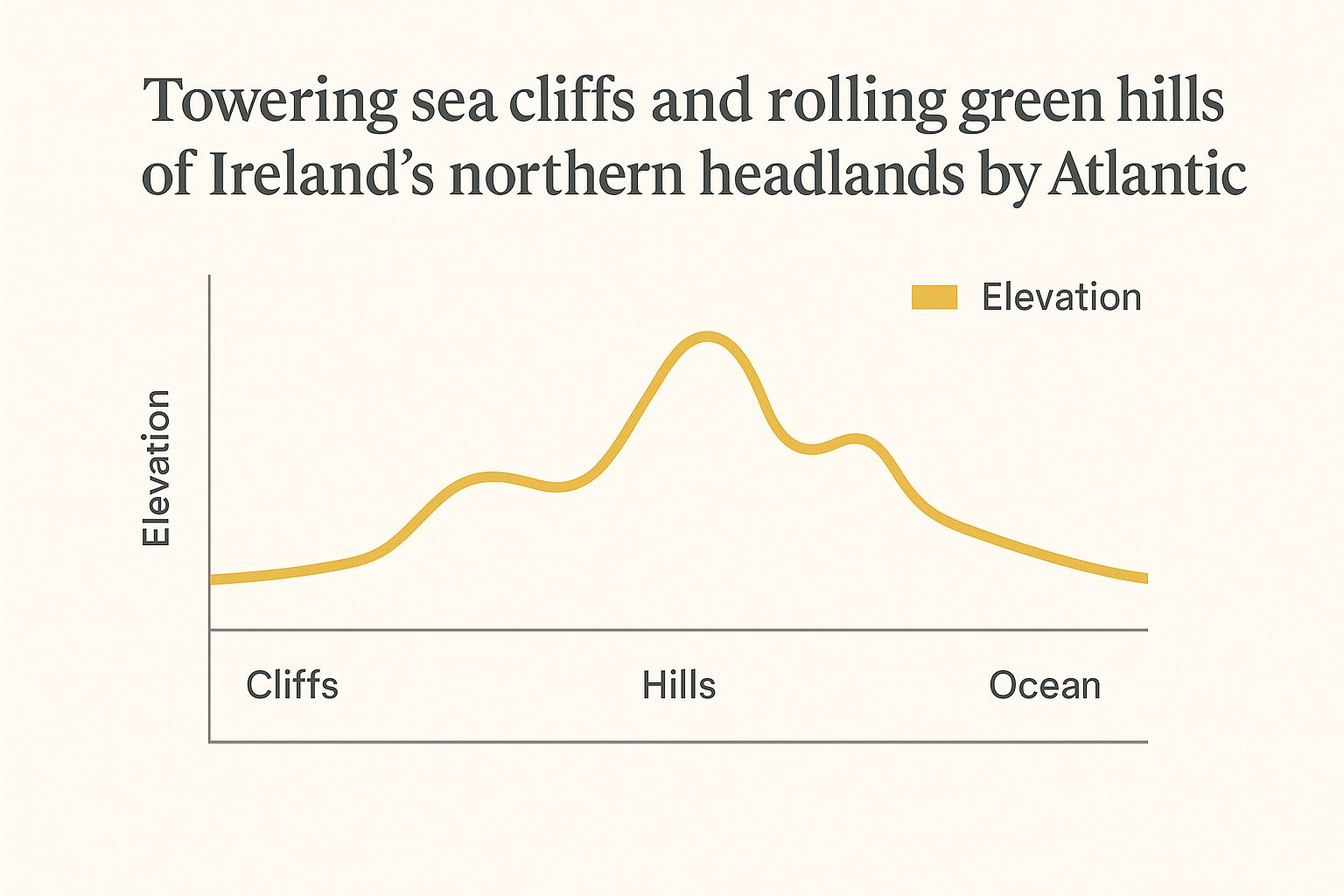
The image really captures the dramatic contrast that makes this region so memorable, where raw coastal power meets serene, pastoral landscapes.
As you explore more of Donegal, be sure to make your way to beautiful spots like Malin Head, Ireland's most northerly point, and the iconic Fanad Head Lighthouse.
Sligo Yeats Country and Ancient Myths
Leaving Donegal behind, you’ll drive south into County Sligo, a landscape that will forever be associated with the poet W.B. Yeats. The distinctive, flat-topped Benbulben mountain and the gentle waters of Lough Gill dominate the scenery, providing the very backdrop for so much of his work. It’s easy to understand why he called it "The Land of Heart's Desire."
A visit here just isn't complete without seeing a few key sites:
- Drumcliffe Churchyard: You can pay your respects at Yeats's final resting place, which sits right in the shadow of the magnificent Benbulben. His simple gravestone bears the famous epitaph: "Cast a cold Eye On Life, on Death. Horseman, pass by!"
- Glencar Waterfall: This enchanting waterfall was another source of inspiration for Yeats and is a beautifully serene spot for a short, peaceful walk.
- Carrowmore Megalithic Cemetery: Here, you can wander through one of the largest and oldest collections of Stone Age tombs in Ireland. Some of these structures date back over 5,000 years.
Sligo is also a bit of a surfer's paradise. The coastal villages of Strandhill and Mullaghmore are famous for their impressive waves, attracting surfers from all over the world. Even if you don’t fancy getting in the water yourself, watching the experts tackle the surf is a spectacle.
Driving through Sligo feels like stepping into a storybook. The mountains, lakes, and ancient monuments are woven into Ireland’s rich tapestry of myths and legends, making every stop feel significant.
This part of your journey really connects you to the country's literary soul and its deep, mystical past.
Mayo Remote Beauty and Prehistoric Wonders
Continuing south, County Mayo offers a different kind of wildness altogether. It’s home to some of the most remote and breathtaking scenery in the entire country. The star attraction here is undoubtedly Achill Island, Ireland’s largest island, which is handily connected to the mainland by a bridge.
Achill is like a microcosm of the entire west coast experience. You’ll find dramatic cliffs, vast, empty boglands, and some of the most beautiful beaches in Europe, like Keem Bay—a perfect horseshoe of golden sand nestled between green hills.
But Mayo’s wonders don't stop there. Head to the north coast to discover the Céide Fields, the most extensive Stone Age monument in the world. This prehistoric landscape of stone walls and tombs is preserved beneath a thick blanket of bog, giving you a fascinating glimpse into a farming community that lived here nearly 6,000 years ago. The award-winning visitor centre does a brilliant job of bringing this ancient world to life.
This final leg of your northern tour perfectly sets the stage for the cultural shift ahead, as you make your way towards the lively, bohemian streets of Galway City—the ideal place to end this unforgettable exploration.
Discovering the Heart of the Wild Atlantic Way
As you leave the wild northern headlands behind, your west coast of Ireland road trip truly enters its most iconic chapter. This is the Ireland you've seen on postcards and heard about in songs—a stunning region where majestic cliffs plunge into the sea and vibrant culture thrives in tiny, colourful villages.
We'll start in County Clare, home to some of the country's most famous natural wonders, before heading south into the legendary peninsulas of County Kerry. This part of the drive is incredibly popular, and for good reason. It’s where you’ll find the showstoppers of the Wild Atlantic Way in Ireland, but it's also where a little insider knowledge goes a long way in helping you sidestep the crowds and find your own magical moments.
County Clare: The Land of Cliffs and Karst
Your first stop in County Clare will almost certainly be the magnificent Cliffs of Moher. Standing 214 metres (702 feet) at their highest point, these sheer cliffs stretch for eight kilometres along the Atlantic coast, offering one of the most breathtaking views in all of Ireland. A little tip: try visiting early in the morning or later in the evening. You'll miss the peak tour bus rush and catch the beautiful golden light of sunrise or sunset.
Just a short drive inland from the cliffs, the landscape transforms into something else entirely: The Burren. This vast, cracked pavement of limestone karst feels almost otherworldly. From a distance, it looks completely barren, but when you get closer, you'll discover a remarkable ecosystem where rare Arctic, Alpine, and Mediterranean plants grow side-by-side in the sheltered crevices.
The Burren is a perfect example of Ireland's hidden depths. It’s a place that asks you to slow down and look carefully, rewarding you with a quiet, subtle beauty that’s unlike anywhere else on Earth. It teaches you that the most amazing discoveries are often found where you least expect them.
After a day of exploring, make your way to the small coastal village of Doolin. It’s known as the traditional music capital of Ireland, and for good reason. Every night, its pubs come alive with the sound of fiddles, tin whistles, and bodhráns. Squeezing into a cosy corner of Gus O’Connor’s or McGann's Pub for an authentic "trad session" is an absolutely essential Irish experience.
County Kerry: The Legendary Rings and Peninsulas
From Clare, a car ferry will take you across the Shannon Estuary and into County Kerry, a region of jaw-dropping coastal drives and lush, green landscapes. This is home to two of Ireland’s most celebrated routes: the Dingle Peninsula and the Ring of Kerry. While many try to rush them, each really deserves at least a full day of unhurried exploration.
The Dingle Peninsula is a firm favourite for many visitors. It’s a bit more compact than its famous neighbour, but it packs an incredible amount of history, culture, and scenery into its winding roads. The Slea Head Drive, a circular route starting and ending in the vibrant town of Dingle, is the main event here.
This drive offers an incredible concentration of sights:
- Ancient History: You'll pass countless ring forts, beehive huts, and ancient standing stones just metres from the roadside.
- Stunning Views: The route offers incredible views of the now-uninhabited Blasket Islands, once a bastion of traditional Irish language and culture.
- Beautiful Beaches: Don’t miss the chance to pull over at Coumeenoole Beach, a gorgeous sandy cove famous for its appearance in the film Ryan's Daughter.
The Ring of Kerry is the larger and more famous of the two drives—a 179-kilometre loop around the Iveragh Peninsula. It takes you through Killarney National Park, with its beautiful lakes and mountains, and along a coastline dotted with charming towns like Sneem and Waterville. Here's a pro tip: drive the route clockwise. All the tour buses travel anti-clockwise, so you'll avoid getting stuck behind them.
Unforgettable Kerry Experiences
Choosing between Ireland's epic cliffs can be tough. The Cliffs of Moher are world-famous, but the towering Slieve League cliffs in Donegal (which you may have already visited) offer a wilder, more remote experience. Here’s a quick comparison to help you appreciate what makes each one so special.
Top Attraction Comparison: Cliffs of Moher vs Slieve League
| Feature | Cliffs of Moher (Co. Clare) | Slieve League (Co. Donegal) |
|---|---|---|
| Height & Scale | 214 metres (702 ft) high, famous for their sheer vertical drop. | Nearly three times higher at 601 metres (1,972 ft). |
| Accessibility | Very accessible with a large visitor centre, paved paths, and tours. | More remote. Requires driving a narrow road; hiking for best views. |
| Crowds | Can be extremely busy, especially during peak tourist season. | Much quieter and less commercialised, offering a sense of solitude. |
| Visitor Experience | Polished and structured. Great for families and those with limited time. | Raw, wild, and adventurous. Ideal for hikers and those seeking nature. |
Ultimately, both are incredible, but they offer very different feelings. The Cliffs of Moher deliver that picture-perfect, 'wow' moment with ease, while Slieve League rewards a bit more effort with untamed, dramatic beauty.
Beyond the main driving routes, County Kerry offers some truly once-in-a-lifetime experiences. One of the most sought-after is the boat trip to Skellig Michael, a remote, jagged island that was home to an ancient monastic settlement and, more recently, a filming location for Star Wars. Be warned: trips are highly weather-dependent and book out months in advance, so plan well ahead if this is on your list.
For those who prefer to stay on land, Killarney National Park is a hiker’s paradise. You can take a gentle stroll around Muckross Lake, visit the stunning Torc Waterfall, or, for the more adventurous, tackle the climb up Torc Mountain for panoramic views over the entire park. The national park is also where you’ll find Muckross House and Gardens, a beautifully preserved Victorian mansion that offers a fascinating glimpse into 19th-century life.
Navigating the Southern Peninsulas of West Cork
As you drift south from Kerry, the final leg of your journey takes you into the soulful and vibrant landscapes of West Cork. This region is a stunning tapestry of rugged peninsulas, colourful harbour towns, and a celebrated food scene—the perfect, flavourful end to your road trip.
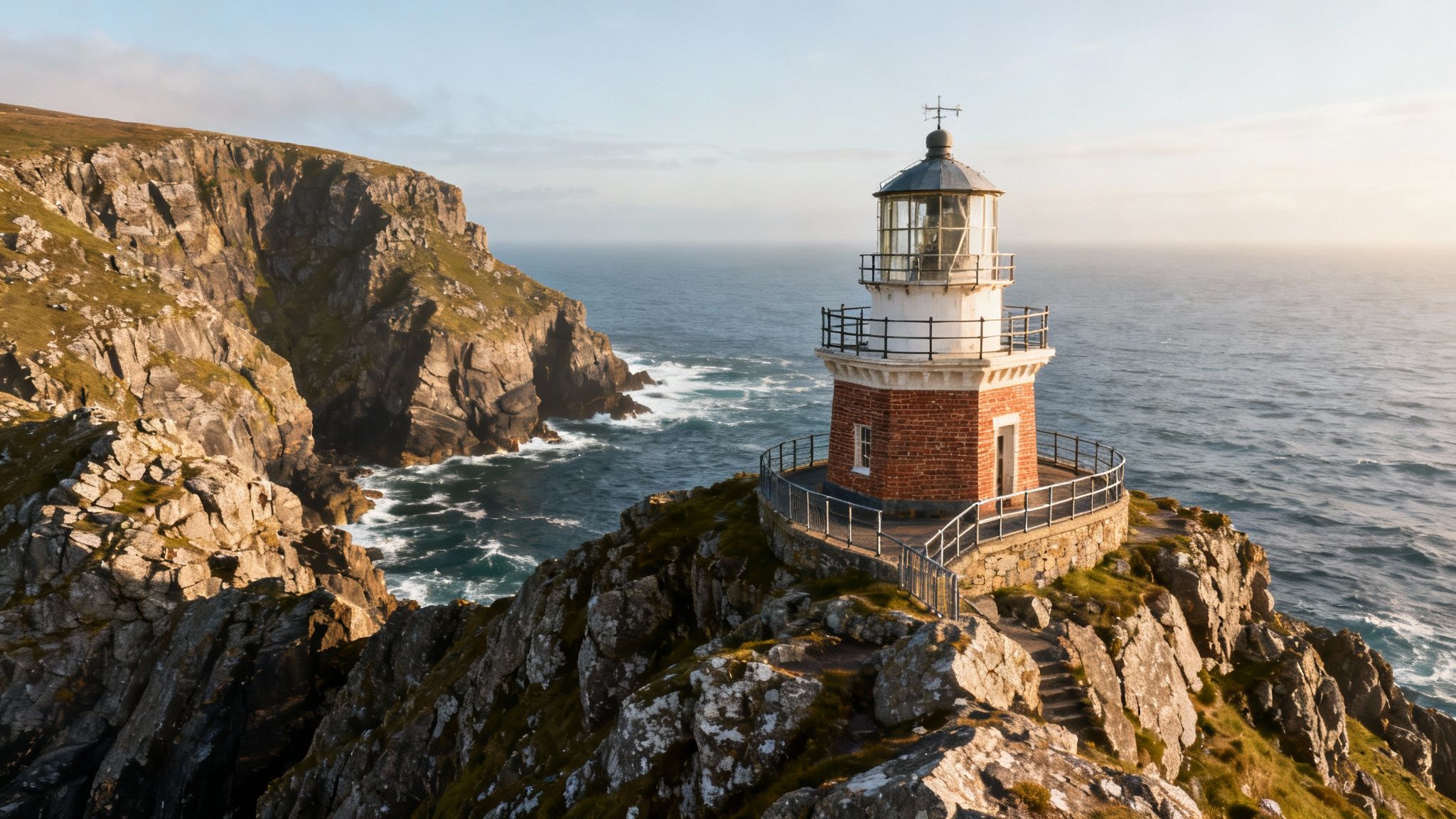
Leaving the grandeur of Kerry behind, you’ll notice a shift in the atmosphere. The pace of life slows right down, and the focus turns to maritime history, local artisans, and some of the best food you’ll find in the country. This is where you swap epic, sweeping vistas for a more intimate, hidden kind of beauty.
The Rugged Charm of the Beara Peninsula
Often overshadowed by its famous northern neighbour, the Ring of Kerry, the Beara Peninsula offers a wilder and far less crowded driving experience. Shared between counties Cork and Kerry, this route is a true hidden gem. It’s all narrow, winding roads that reward your careful driving with breathtaking coastal views and a profound sense of solitude.
As you navigate its twists and turns, you’ll discover a landscape dotted with ancient stone circles, ridiculously colourful villages like Eyeries, and the bustling fishing port of Castletownbere. A particular highlight is the Healy Pass, a zigzagging mountain road cutting across the peninsula's spine. The panoramic views from the top are simply unforgettable.
Reaching Ireland's Teardrop: Mizen Head
Your journey south continues to the next major landmark: Mizen Head, Ireland’s most southwesterly point. It's known affectionately as "Ireland's Teardrop," as it was the very last piece of home that Irish emigrants saw when they sailed for America. Today, it’s a spectacular visitor attraction.
Getting to the signal station involves crossing the iconic Mizen Head Bridge, which arches dramatically over a deep sea gorge. The surrounding cliffs are a haven for seabirds, and if you’re lucky on a clear day, you might even spot dolphins or whales in the waters below. It's a powerful, atmospheric place that connects you right to Ireland’s deep maritime history.
West Cork isn’t just a place on a map; it's a feeling. It’s the salty air, the warmth of a local pub, and the taste of seafood straight from the ocean. It’s the perfect place to slow down and simply savour the final moments of your incredible drive.
This region really encourages you to appreciate the smaller details and the rich character of its coastal communities.
The Culinary Capital of Kinsale
Your road trip culminates in the picture-perfect harbour town of Kinsale. With its winding medieval streets, brightly painted buildings, and world-class restaurants, it’s widely celebrated as the gourmet capital of Ireland. For any food lover, this is the ultimate destination.
Kinsale’s reputation is built on its incredible access to fresh, local produce—especially seafood. The town is brimming with exceptional dining options, from Michelin-starred establishments to cosy pubs serving the best fish and chips you’ll ever taste.
Here are a few things you shouldn’t miss:
- Stroll the Harbour: Take a relaxed walk along the waterfront, admiring the yachts and fishing boats that fill the marina.
- Explore Charles Fort: This massive, star-shaped fort offers a fascinating glimpse into military history and provides stunning views back over the town and harbour.
- Discover Local Art: Kinsale is home to numerous art galleries and artisan shops, perfect for finding a unique souvenir to remember your trip by.
After exploring the entire length of Ireland's magnificent west coast, from the wild cliffs of Donegal to the serene harbours of Cork, Kinsale provides a warm, welcoming, and utterly delicious end to your adventure. It’s the perfect place to relax, reflect on your journey, and raise a final glass to the open road.
Practical Tips for Driving the West Coast of Ireland
https://www.youtube.com/embed/yUQj4mt9boI
Now that you've got a sense of the route, let's get into the nitty-gritty details that make a road trip run smoothly. A little bit of prep work now will save you a world of hassle later, helping you handle everything from the winding roads to Ireland's famously fickle weather with total confidence.
This is your go-to guide for all the practical stuff. We’ll talk about renting a car, what to pack, where to stay, and how to budget, so you're ready for anything the Wild Atlantic Way throws at you.
Renting a Car and Navigating the Roads
First, the big one: in Ireland, we drive on the left-hand side of the road. If you're coming from a country that drives on the right, it will feel a bit strange for the first hour or so, but trust me, you'll get the hang of it faster than you think. Also, most rental cars here are manual (stick shift), so if you need an automatic, make sure you book it well ahead of time and be prepared for it to cost a bit more.
The roads along the west coast are a huge part of the adventure. They can be incredibly narrow and winding, often with old stone walls right at the edge. There’s no need to rush. Take your time, pull into a lay-by to let faster local drivers pass, and always keep an eye out for tractors or even a few wandering sheep. It's all part of the charm!
What to Pack for Irish Weather
You've probably heard the old saying that Ireland can have four seasons in a single day, and it's absolutely true. The secret to staying comfortable isn't to pack for one type of weather, but to pack layers that you can easily add or remove.
Here’s a packing list that has never failed me:
- A Solid Waterproof Outer Layer: A good waterproof and windproof jacket is a must-have. Honestly, don't leave home without one. Waterproof trousers are a brilliant addition, too.
- Warm Mid-Layers: Think fleeces, woolly jumpers, or a light down jacket. These are perfect for trapping heat when you need it and are easy to shed when the sun appears.
- Comfortable Footwear: You'll want sturdy, waterproof walking shoes or boots for exploring the cliffs and trails. It's also nice to have a more comfortable pair of shoes for relaxing in the evenings.
- The Finishing Touches: A warm hat, gloves, and a scarf will be your best friends on a blustery coastal walk, no matter the time of year.
For a more comprehensive checklist, especially if you're travelling with others, it’s worth looking over some lists of essential family road trip items that you can easily adapt.
Accommodation: From B&Bs to Boutique Hotels
The west coast is dotted with fantastic places to stay, with something for every taste and budget. For a truly Irish experience, you can't do better than a traditional Bed & Breakfast (B&B). They're usually run by local families who offer the warmest of welcomes and a legendary "Full Irish" breakfast to set you up for the day.
If you’re looking for a few more creature comforts, you'll find plenty of wonderful hotels, from cosy country inns to chic boutique spots. Just a word of warning: during the high season from June to August, I'd strongly recommend booking your accommodation in advance, particularly in hotspots like Dingle and Galway.
Budgeting for Your Trip
How much you spend really depends on your travel style, but it helps to have a rough idea of the costs. International tourism is the lifeblood of the west coast. In a recent year, Ireland saw 6.3 million overseas visitors, and the spending from tourism is a massive part of the national economy.
Knowing your budget is about more than just numbers; it’s about giving yourself the freedom to enjoy the trip without worrying about every euro. When you plan for the big things—fuel, food, accommodation—you can relax and just soak in the incredible views.
Here’s a quick breakdown to help with your planning:
- Fuel: This will be one of your biggest expenses. Petrol and diesel are more expensive here than in the US, so it's wise to work this into your daily budget.
- Food: For a main course in a decent pub or mid-range restaurant, expect to pay around €15-€25. A great way to save a bit is to grab sandwiches and snacks from a local shop for lunch.
- Activities: The best views are often free, but you'll want to budget for entry fees to places like the Cliffs of Moher, historic castles, or maybe a boat trip out to the islands.
If this all sounds amazing but you'd rather someone else handle the planning, our customisable self-drive tours take care of all the logistics for you, so you can just focus on the driving and the scenery.
At BTOURS, we specialise in creating unforgettable self-drive holidays that let you explore the world at your own pace. Discover your next adventure with us at https://www.btours.com.

